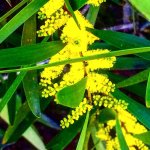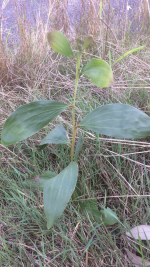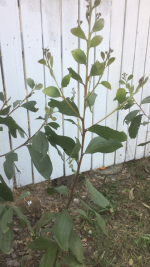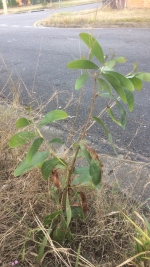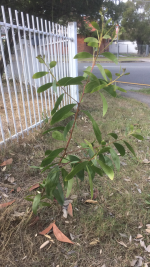Probably an Albizia Julibrissin.
-
Members of the previous forum can retrieve their temporary password here, (login and check your PM).
You are using an out of date browser. It may not display this or other websites correctly.
You should upgrade or use an alternative browser.
You should upgrade or use an alternative browser.
Botany Acacia and Mimosa Identification Thread
- Thread starter endlessness
- Start date
Growing logs with advice and results.
Migrated topic.
Lupis Arante
Rising Star
Structuredbliss said:Hi everyone, I’ve found some trees locally and am unsure of their species. I have seen another picture on this thread giving me the feeling it’s A. simsii, A. Miltisiliqua but could be something else. Located in SA by the way
That looks like an Acacia rigens
Aussieguy30 said:Hey guys wanted to get an id on this searched for while before finding somewhere that these plants were know to be of two species. A. Longfolia. And a. concurrens.
I am still new and searching so I hope that I can get an id on this tree found in searching Queensland.
That looks far more like Acacia auriculiformis
Scruffyjack
Rising Star
Hi all,
First time posting and I’m hoping there’s still some knowledgeable people left on the forums! I’m trying to find some A.Acuminata, for any aussies on here yes I’m a perth boy. Before I post the pics that does bring up a good point of everything thing I’ve read and the beginning of my adventures, everyone keeps saying York is the place to go, but after two 1.5 hour drives there I’ve come back with little to show for, so if anyone could reach out to me and give me a hand that would be so greatly appreciated. The last time I bought ‘dmt’ I was ripped off and left with a gram of useless rubbish that did nothing but make me sick, which has brought me here with the desire to extract myself. I of course don’t want to destroy these trees and would only harvest the phyllodes and twigs/already snapped branches, but this ’abundance’ out in York has left me wondering. Anyway I digress, I’ve got 3 samples but I’m not confident in them being Acuminata but definitely different varieties of acacia. Hopefully someone can help.
Much love to you all
First time posting and I’m hoping there’s still some knowledgeable people left on the forums! I’m trying to find some A.Acuminata, for any aussies on here yes I’m a perth boy. Before I post the pics that does bring up a good point of everything thing I’ve read and the beginning of my adventures, everyone keeps saying York is the place to go, but after two 1.5 hour drives there I’ve come back with little to show for, so if anyone could reach out to me and give me a hand that would be so greatly appreciated. The last time I bought ‘dmt’ I was ripped off and left with a gram of useless rubbish that did nothing but make me sick, which has brought me here with the desire to extract myself. I of course don’t want to destroy these trees and would only harvest the phyllodes and twigs/already snapped branches, but this ’abundance’ out in York has left me wondering. Anyway I digress, I’ve got 3 samples but I’m not confident in them being Acuminata but definitely different varieties of acacia. Hopefully someone can help.
Much love to you all
Ypsilophora
Rising Star
Hey,
Don’t have any photos ATM, but would love someon to point me in the right direction for differing A. Longifolia and A. Floribunda... am I right in thinking that longifolia has basal glands whereas floribunda does not? Beyond that, particular tree is about to start flowering now, which would point to floribunda maybe? I do know it’s one of the two because I planted them (yes, I know... I can’t even remember which ones I planted where haha... it was 10 years ago to be fair :lol: ). Phyllodes also have very small hairs, mostly around the base, but sometimes reaching along the whole length.
Cheers,
Yp
Don’t have any photos ATM, but would love someon to point me in the right direction for differing A. Longifolia and A. Floribunda... am I right in thinking that longifolia has basal glands whereas floribunda does not? Beyond that, particular tree is about to start flowering now, which would point to floribunda maybe? I do know it’s one of the two because I planted them (yes, I know... I can’t even remember which ones I planted where haha... it was 10 years ago to be fair :lol: ). Phyllodes also have very small hairs, mostly around the base, but sometimes reaching along the whole length.
Cheers,
Yp

Ypsilophora said:Hey,
Don’t have any photos ATM, but would love someon to point me in the right direction for differing A. Longifolia and A. Floribunda... am I right in thinking that longifolia has basal glands whereas floribunda does not? Beyond that, particular tree is about to start flowering now, which would point to floribunda maybe? I do know it’s one of the two because I planted them (yes, I know... I can’t even remember which ones I planted where haha... it was 10 years ago to be fair :lol: ). Phyllodes also have very small hairs, mostly around the base, but sometimes reaching along the whole length.
Cheers,
Yp
I'll chime in on Acacia Floribunda as I have spent more time with it than Longifolia and am better qualified to comment on its varying taxonomy. It is void of a basal gland, has looser, longer and paler flower spikes than longifolia's. Phyllodes of Longifolia are more leathery than those of Floribunda.. while the latter trends towards a softer more papery texture .. at times slightly hairy.. at times not. Floribunda more often than not has a weeping habit like that of a willow. I won't say that all do as I have comes across many erect specimens..particularly cultivars in drier areas. I have an inkling that the two interbreed.. around urban areas there seem to be a lot of trees that have features intermediate between the two and you will commonly find them in close proximity to each other due to their popularity. The same I think happens with Acacia Mucronata and Floribunda..
Having spent a lot of time looking at Floribunda I can its an interesting species to study.. I think particularly because it is so widely cultivated in urban areas it is also highly variable in taxonomy as well as alkaloid presence/profile due to interbreeding with the local Acacia's in differing regions as well as growing in differing ecosystems all with their own differing soil compositions, weather patterns etc. Hope this is helpful..
Here's some photos of various forms of floribunda.. notice the tighter flower rods in the more erect specimens and the general tend towards loose flowers in the weeping varieties (but again.. not always)
Can't seem to be able to get photo embedding to work instead here are some links to various forms of Floribunda
Long loose flowers.. erect habit that will probably weep as it gets taller. This is a coastal specimen.
Another beauty
Variety with shorter and tighter flowers...erect growth habit. Often appears like this when cultivated in drier urban areas
Possibly intermediary with Longifolia.. void of basal gland but certainly not a "normal" specimen
Perhaps the "true" form in terms of its alignment to the classically defined taxonomy of the species
Ypsilophora
Rising Star
thanks Acacian and Chimp Z.
I do suspect it to be a floribunda, seems inactive (or very very low concentration) as well, but it is coming into flower, so we shall see when I try another extraction.
I do suspect it to be a floribunda, seems inactive (or very very low concentration) as well, but it is coming into flower, so we shall see when I try another extraction.
Ypsilophora said:thanks Acacian and Chimp Z.
I do suspect it to be a floribunda, seems inactive (or very very low concentration) as well, but it is coming into flower, so we shall see when I try another extraction.
if i can recommend one thing do not use shellite (assuming your in oz?) for floribunda extraction. it works very poorly and you will often end up with misleading results (in fact it works very poorly in general now if you are using the diggers brand).. always got way better results using toluene with this tree and the extracts are wayy cooler than the shellite extracts
If you are extracting from floribunda in highly urban areas I would recommend testing some a bit further out in the bush.. they seem to work better.. phyllodes and twig generally have healthy content but whenever i have done extractions on city grown floribunda have come up with negative results.
Ypsilophora
Rising Star
Hey Acacian,
Thanks for the tips. I have stopped using shellite, as I found, as you stated, that it had pretty terrible pulling ability.
I have started using Xylene, it's revoltingly smelly stuff, but much more efficient than shellite. Live very rurally, so don't have local access to Toluene.
I'll do another test shortly, although phyllodes didn't offer much oral activity at quite high dosages (plus syrian rue).
Have you found a difference in alkaloid profile between the more erect and the weepy growth type? Only asking because the ones that are more erect ones seem to have more sparse phyllode arrangement, with the phyllodes more erect and stiff (the phyllodes themselves are still pretty supple, they just stick out more)... reminiscent of A. obtusifolia.
Thanks for the tips. I have stopped using shellite, as I found, as you stated, that it had pretty terrible pulling ability.
I have started using Xylene, it's revoltingly smelly stuff, but much more efficient than shellite. Live very rurally, so don't have local access to Toluene.
I'll do another test shortly, although phyllodes didn't offer much oral activity at quite high dosages (plus syrian rue).
Have you found a difference in alkaloid profile between the more erect and the weepy growth type? Only asking because the ones that are more erect ones seem to have more sparse phyllode arrangement, with the phyllodes more erect and stiff (the phyllodes themselves are still pretty supple, they just stick out more)... reminiscent of A. obtusifolia.
Ypsilophora said:Have you found a difference in alkaloid profile between the more erect and the weepy growth type? Only asking because the ones that are more erect ones seem to have more sparse phyllode arrangement, with the phyllodes more erect and stiff (the phyllodes themselves are still pretty supple, they just stick out more)... reminiscent of A. obtusifolia.
Not really.. more found it to be an area thing.. For whatever reason I have never had much success in trees growing around built up urban areas. Location does seem to be a big variable with floribunda.
Jagube
Established member
That's good news. I think someone said on the Nexus that the weeping forms are inactive and I have two trees of the weeping form. Now I know there is hopeacacian said:Not really.. more found it to be an area thing.. For whatever reason I have never had much success in trees growing around built up urban areas. Location does seem to be a big variable with floribunda.
I've bioassayed teas and extracts with inconclusive results, but will revisit it.
Currently I'm testing my A. retinodes, along with a few other projects.
Yeah I have had plenty of success with weeping forms..
Phangz
Seeking...
Hi Acacian,
I'm very, very new to field of plants. Mainly have just grown fruits and veggies in the garden. However, I have positively identified an Acacia podalyriifolia. Would it be worth the effort for my first time ever extraction?? I have read conflicting data and you seem very knowledgeable on this matter. Plants are just starting to flower.
Let me know your thoughts.
Thanks.
Also, there's plenty more of different species along the highway I haven't had a chance to try and i.d yet. But will get pics and post as soon as i can. It's amazing how many i see driving around without even trying to spot them now.
I'm very, very new to field of plants. Mainly have just grown fruits and veggies in the garden. However, I have positively identified an Acacia podalyriifolia. Would it be worth the effort for my first time ever extraction?? I have read conflicting data and you seem very knowledgeable on this matter. Plants are just starting to flower.
Let me know your thoughts.
Thanks.
Also, there's plenty more of different species along the highway I haven't had a chance to try and i.d yet. But will get pics and post as soon as i can. It's amazing how many i see driving around without even trying to spot them now.
Hi Phangz 
As far as I am aware there haven't been any findings of dmt in podalyrifolia. I remember some time ago a member here obtained a crystalline extract from it, which upon bioassay I believe turned out to be inactive. For research-sake I would say it is of course worthwhile as it will contribute to the data we have on the plant - however if you are after something with good DMT content your efforts may be better focused elsewhere..
A number of people who work with acacia's feel that nerve anastomisation is a potential indiactor of activity in species.. certainly if you look at the knwon active species they all share this in common, although there have been findings in species that don't have this trait. I would go with whatever plant you vibe with..
As far as I am aware there haven't been any findings of dmt in podalyrifolia. I remember some time ago a member here obtained a crystalline extract from it, which upon bioassay I believe turned out to be inactive. For research-sake I would say it is of course worthwhile as it will contribute to the data we have on the plant - however if you are after something with good DMT content your efforts may be better focused elsewhere..
A number of people who work with acacia's feel that nerve anastomisation is a potential indiactor of activity in species.. certainly if you look at the knwon active species they all share this in common, although there have been findings in species that don't have this trait. I would go with whatever plant you vibe with..
Phangz said:It's okay. Just got told they are Acacia leiocalyx. Oh well....
Would have been good if they was something good because they're unwanted where they are at and would have been a good score of free plants!! =P.
Hey Phangz.. it is also very likely that it is Acacia Concurrens.. very similar looking trees.. differences are very subtle too so I would do a bit of research on the differences between the two. A friend of mine recently had good results with concurrens in northern NSW..
Both Leiocalyx and Concurrens are part of a "taxonomically difficult" group of very similar looking species .. known as the Cunninghamii group.. any tree in this group is worthy of research too they seem to yield quite good results and are also very common and easy to grow..
Phangz
Seeking...
Hey Acacian,
Thanks for the reply.
Took your advice and did a little bit of study on the two species. Differences between them are subtle indeed. Apart from the different colouring of their branchlets, almost everything else is the same.
Leiocalyx having a reddish colour while Concurrens been brown. I looked at my photos again and it looks more red than brown. But it's to hard to say for sure. Will try and see if there is any other subtleties i can find and go back and inspect the plants in person again. Any cheat codes you can give?? =P
Still just the tip of the ice berg - still so, so many out there.
BTW which species are the weeping form you mentioned in earlier post??
Thanks for the reply.
Took your advice and did a little bit of study on the two species. Differences between them are subtle indeed. Apart from the different colouring of their branchlets, almost everything else is the same.
Leiocalyx having a reddish colour while Concurrens been brown. I looked at my photos again and it looks more red than brown. But it's to hard to say for sure. Will try and see if there is any other subtleties i can find and go back and inspect the plants in person again. Any cheat codes you can give?? =P
Still just the tip of the ice berg - still so, so many out there.
BTW which species are the weeping form you mentioned in earlier post??
Phangz said:Hey Acacian,
Thanks for the reply.
Took your advice and did a little bit of study on the two species. Differences between them are subtle indeed. Apart from the different colouring of their branchlets, almost everything else is the same.
Leiocalyx having a reddish colour while Concurrens been brown. I looked at my photos again and it looks more red than brown. But it's to hard to say for sure. Will try and see if there is any other subtleties i can find and go back and inspect the plants in person again. Any cheat codes you can give?? =P
Still just the tip of the ice berg - still so, so many out there.
BTW which species are the weeping form you mentioned in earlier post??
I would have been talking about Floribunda.. although I don't believe weeping or no to be a factor in alkaloid activity.

